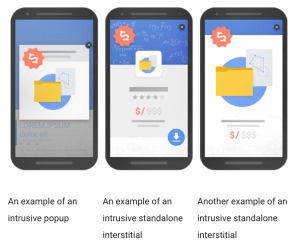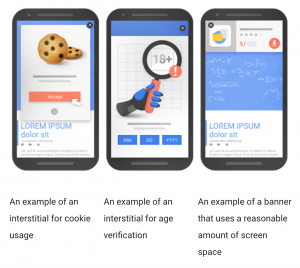In late 2016, Google warned that they were going to begin penalizing websites that used pop-ups on their pages. Their goal was to influence site owners to improve the mobile search experience by making web browsing on a mobile device more user-friendly, accessible, and usable. As advertising revenues have declined and more and more users have adopted ad-blockers, publishers are looking for other sources of revenue, which usually comes in the form of annoying promotional strategies for users.
In January 2017, Google announced that pages that have pop-ups that visibly hide information from users may not rank as highly anymore in search results. This penalty is preventing intrusive interstitials (pages displayed before the expected page) that block users from viewing the underlying content on the site. On many sites, visitors have to actively close a popup before being able to reach the main content. This proves to be problematic, especially on mobile devices where screens are much smaller. However, this isn’t necessarily a huge penalty; this signal is just one of hundreds that are used to decide where a page should appear in search results, so a page with pop-ups and interstitials is still able to rank highly if it has highly relevant content to the user’s search query.
To clarify; no, Google is not banning pop-ups. While their aim was to preserve the user-experience by downranking offenders, Google is still aware that pop-ups work. Really well. They make exceptions to select interstitials and pop-ups; for example, the ones required by law for cookie usage or age verifications. They even accept banners that use a reasonable amount of space and are easily dismissible.
Also, this penalization only applies to mobile sites, NOT desktops. Many pop-up plugins allow you to turn off your pop-ups on mobile devices. It also only matters in the transition from search results to the entry page (the first page viewed). So, technically, you could just set up your popup to show on the second or third page. Keep in mind that every page on a site has the potential to be an entry page, so tie the interstitial to the number of clicks of your user.
Mobile devices make up around 56% of traffic to top sites, and mobile traffic shows no signs of slowing anytime soon. This means that you want to take care of your visitors, not only for the sake of ranking in Google, but also to improve the user experience, and hopefully welcome more organic search traffic. Look for non-intrusive ways to generate revenue, using content-based marketing strategies to educate and guide users; think blog posts, guides, infographics, videos etc.




